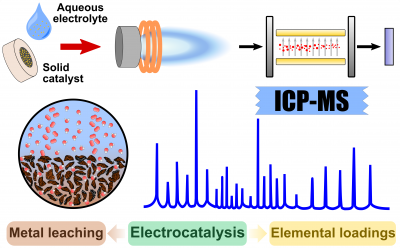Determining Elemental Compositions of Transition Metal-based Electrocatalysts in Solid and Electrolyte Samples Through Solution-mode ICP-MS

|
Electrocatalytic materials based on transition metals and non-metal compounds represent a promising alternative for future energy applications. However, there is still debate over whether these materials are truly stable, which is critical in ensuring their commercial application. Therefore, there is a need for robust and reliable analytical methods capable of measuring the material’s composition changes before, during, and after stability tests. |
We propose a method for determining elemental loadings in solid catalysts and metal dissolution rates into alkaline electrolytes using solution-mode inductively coupled plasma mass spectrometry (ICP-MS). Due to its high sensitivity and low detection limits, ICP-MS will detect changes in our electrocatalysts’ composition accurately and precisely, thereby providing an effective way to inspect the catalytic stability. |
|
Through our method, we want to: (i) Determine the elemental composition (i.e., Ni, Co, P, and Se) of metal-organic framework (MOF) catalytic precursors. (ii) Examine the dissolution of Ni and Fe from solid NiFe catalysts by sampling the alkaline electrolyte during stability tests. (iii) Optimize the method for analyzing challenging KOH electrolyte samples with high TDS (~5.6 wt.%) |
The Method
The method’s performance was optimized for the analysis of 15 masses in no gas, helium, and hydrogen modes. The instrument was tuned for low production of oxides (CeO+/Ce+<1.2%) and He and H2 modes were optimized for detection of challenging Se and Fe isotopes. S/N ratios were above 100 for most of the analytes of interest (i.e., Ni, Co Fe). All analytes exhibited R2 >0.9998 and detection limits below 5 ppb. Quality control samples exhibited high recoveries (±10%) and spiked samples confirmed the high precision and accuracy of the method (RSD <2%). |
|
The composition of MOF precursors was determined, with elemental ratios close to expected values from synthesis. Transition metal concentrations in challenging KOH electrolyte samples were effectively measured through a simple 2000x dilution procedure. The main elements present in purified and unpurified KOH electrolyte were identified. Finally, results suggest that Ni and Mn re-absorption into solid electrodes occurs after initial dissolution during cycling stability tests. |
In the future, the proposed KOH electrolyte-testing procedure will be extended to pyrolyzed MOF catalysts to examine their stability, as demonstrated for NiFe materials. We hope to investigate the dissolution-incorporation relationship of other species that have been detected during cycling, including as selenates (SeOx), tellurates (TeOx), and borates (BOx). Understanding these processes will improve the design and fabrication of robust and durable materials for energy applications. |
Please check these links for further details about this project:
The members of our team can be found here.
Supplementary information can be found here, including: compositions of stock solutions, instrument tuning parameters, operation modes, semiquantitative analysis, method’s sequence, calibration curves, and data reduction tables.
A full list of our references and previous studies can be found here.